#the surface of venus is made of lens caps
Text
So Venus is my favorite planet in the solar system - everything about it is just so weird.
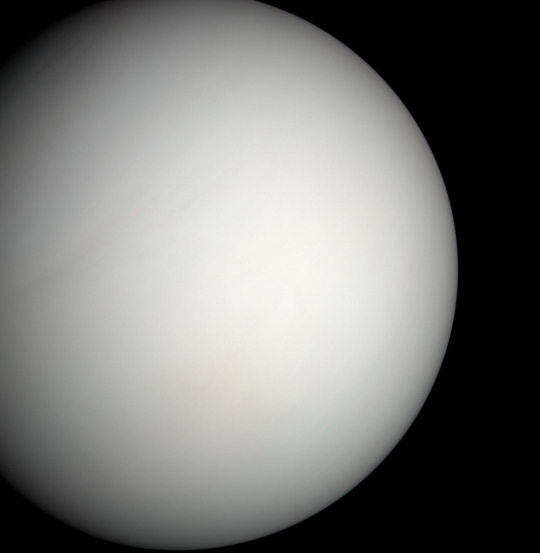
It has this extraordinarily dense atmosphere that by all accounts shouldn't exist - Venus is close enough to the sun (and therefore hot enough) that the atmosphere should have literally evaporated away, just like Mercury's. We think Earth manages to keep its atmosphere by virtue of our magnetic field, but Venus doesn't even have that going for it. While Venus is probably volcanically active, it definitely doesn't have an internal magnetic dynamo, so whatever form of volcanism it has going on is very different from ours. And, it spins backwards! For some reason!!
But, for as many mysteries as Venus has, the United States really hasn't spent much time investigating it. The Soviet Union, on the other hand, sent no less than 16 probes to Venus between 1961 and 1984 as part of the Venera program - most of them looked like this!

The Soviet Union had a very different approach to space than the United States. NASA missions are typically extremely risk averse, and the spacecraft we launch are generally very expensive one-offs that have only one chance to succeed or fail.
It's lead to some really amazing science, but to put it into perspective, the Mars Opportunity rover only had to survive on Mars for 90 days for the mission to be declared a complete success. That thing lasted 15 years. I love the Opportunity rover as much as any self-respecting NASA engineer, but how much extra time and money did we spend that we didn't technically "need" to for it to last 60x longer than required?
Anyway, all to say, the Soviet Union took a more incremental approach, where failures were far less devastating. The Venera 9 through 14 probes were designed to land on the surface of Venus, and survive long enough to take a picture with two cameras - not an easy task, but a fairly straightforward goal compared to NASA standards. They had…mixed results.
Venera 9 managed to take a picture with one camera, but the other one's lens cap didn't deploy.
Venera 10 also managed to take a picture with one camera, but again the other lens cap didn't deploy.
Venera 11 took no pictures - neither lens cap deployed this time.
Venera 12 also took no pictures - because again, neither lens cap deployed.
Lotta problems with lens caps.
For Venera 13 and 14, in addition to the cameras they sent a device to sample the Venusian "soil". Upon landing, the arm was supposed to swing down and analyze the surface it touched - it was a simple mechanism that couldn't be re-deployed or adjusted after the first go.
This time, both lens caps FINALLY ejected perfectly, and we were treated to these marvelous, eerie pictures of the Venus landscape:

However, when the Venera 14 soil sampler arm deployed, instead of sampling the Venus surface, it managed to swing down and land perfectly on….an ejected lens cap.
#space#space history#venus#NASA#Venera#spost#I will talk all day about venus#ask me about venus floating sky cities#unpopular opinion venus > mars#this is probably my favorite space history story#the surface of venus is made of lens caps#don't try to tell me the universe doesn't have a sense of humor#well#I guess its more that people have a sense of humor and we happen to live in the universe
28K notes
·
View notes
Photo
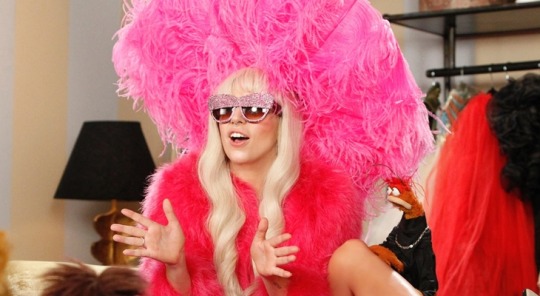
FASHION CREDITS: LADY GAGA & THE MUPPETS HOLIDAY SPECTACULAR
Lady Gaga teamed up with the Muppets for a Thanksgiving night special on ABC! The 90-minutes “Holiday Spectacular” aired on November 28, 2013 where Gaga performed songs from her album “ARTPOP” including a duet with Kermit the Frog, Elton John, Joseph Gordon-Levitt, and legendary RuPaul!
Styling by Brandon Maxwell. Hair by Frederic Aspiras & makeup by Tara Savelo.
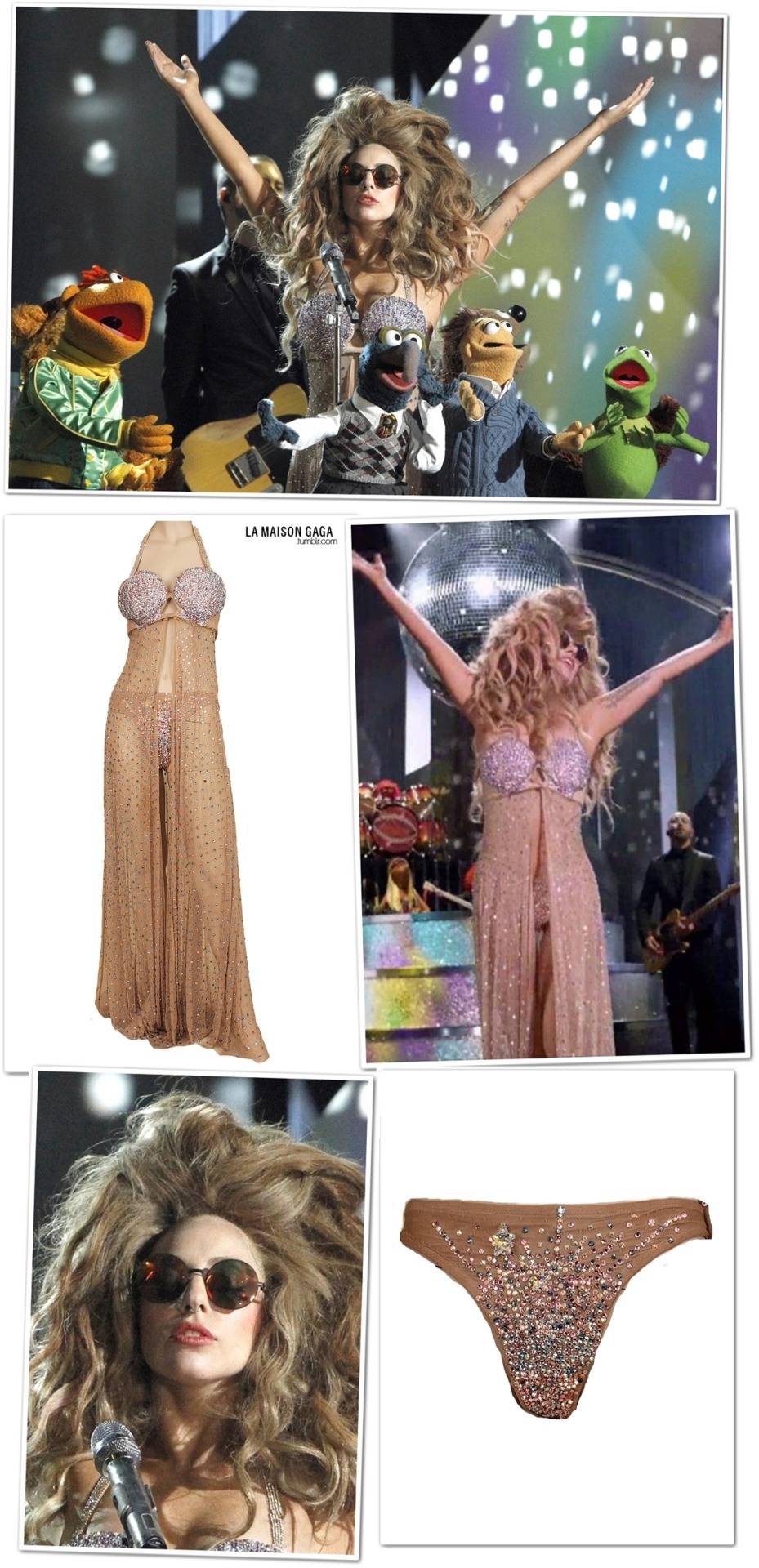
Starting off with a ‘Venus’ performance, Gaga wore a bespoke three-piece ensemble custom-made by Los Angeles-based art director and costume designer Maggie Barry, one of the designers you can find in LA’s Premier Showroom, Style PR.
The open-front nude gown, crystallized seashell halter bustier top and matching pavé bikini bottom, feature 8,943 pink & blue Swarovski crystals.
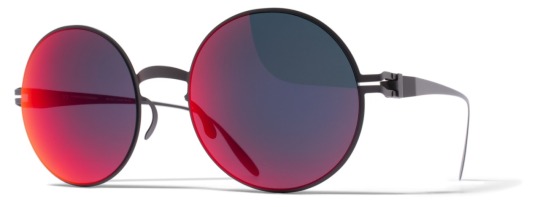
She accessorized the look with the MYKITA x Bernhard Willhelm Janis shades, named after rock singer Janis Joplin. She opted for the lens color “Scarlet Flash”.

Two of her talented dancers are seen dancing in constructed bodysuits with metallic gold and gradient waves from Tel Aviv-based designer Alon Livné’s Spring/Summer 2014 collection, which we’ll see more from later!

During the scene with Miss Piggy and Kristen Bell, Gaga wore a crystal embellished powder pink dressing gown with oversized tonal fur cuffs and seashell chest piece.
The old Hollywood glam piece was custom-made for her by Dsquared².

For ‘Applause’ it’s a bespoke Versace sleeveless plunging jumpsuit covered in metallic silver rings and small golden Swarovski crystals, and metal mesh dip back wrap skirt - all based on the Fall/Winter 2012 collection.

The necklace, featuring Swarovski crystals hand-set into an intricate 24k vermeil filigree surface, belongs to Erickson Beamon “Hello Sweetie” collection.
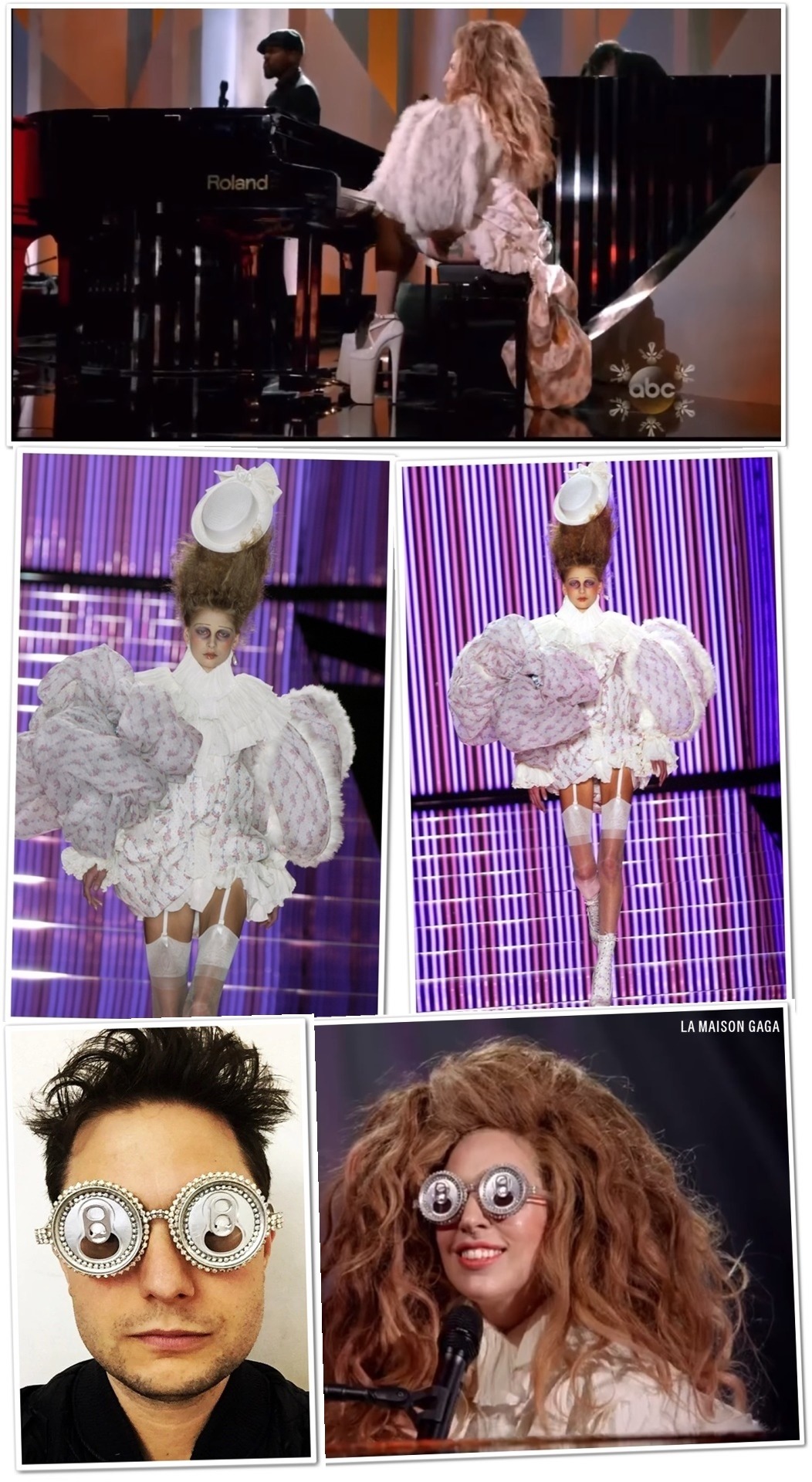
I believe many of you have instantly recognized the Victorian doll-inspired creation Gaga wore, as she donned a couple of pieces from the same collection on her way to Germany and upon her arrival in Berlin.
The dramatic showpiece was the opening look from John Galliano’s Spring/Summer 2004 runway, featuring asymmetric voluminous draped flower and fur-trimmed lantern sleeves, tiers of ruffles and draped tail.

The look was styled with custom-made a-morir beverage can sunglasses...

...and a pair of towering Pleaser white vinyl criss-cross Beyond-087 pumps.

Next, Gaga tries to brainstorm ideas for the big finale with the Muppets.
She’s wearing a pink Adrienne Landau marabou cropped jacket (similar pictured) on top of a pink silk organza dress with sculpted cut-out bodice from the aforementioned Alon Livné Spring/Summer 2014 collection!
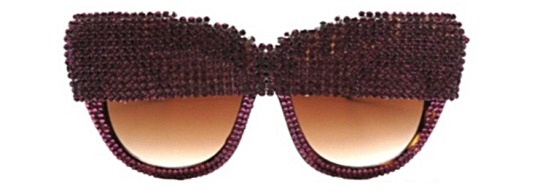
Oversized Philip Treacy ostrich feather hat, custom pink a-morir Janet sunnies and crystal-embellished pink and black cap-toe pumps completed the look.

Her Swarovski crystal-embellished pumps are Giuseppe Zanotti. The pink pump with black cap toe is a custom version of his Muffa model.

For the performance of ‘Manicure’, Gaga rocked the stage in one of her many Saint Laurent plaid flannel Western shirts from the Fall/Winter 2013 collection.

The button-down was accessorized with a-morir Ralf Hütter-inspired Hutter glasses and thigh-high stretch suede platform boots with metal heels.
The eyeglasses are amplified with an oversized circular lucite extension and polished off with large black Swarovski elements crystal cup chain on the outer circle and medium sized crystals crystal cup chain on the inner frame.

For her ‘Gypsy’ duet with Kermit, Gaga changed into a custom rust-dyed fox fur cocoon coat by Helen Yarmak (similar pictured above).
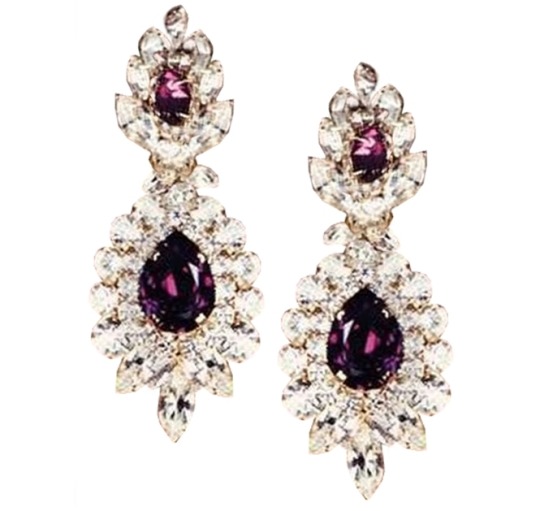
Her purple, gold and silver crystal earrings are vintage House of Lavande.

During her ‘Baby It’s Cold Outside’ duet with Joseph Gordon-Levitt, Gaga wore a bodysuit with criss-cross halter neckline and back detail, and a matching slinky red mermaid maxi skirt.
The glossy acetate knit vintage set was presented on Alaïa Spring/Summer 1986 runway, just a few months before Gaga was born!

A pair of Le Silla’s crystal pavé nude suede pointed-toe pumps completed the entire look.

This next piece was one of Ava Gardner’s personal gowns!
The eye-catching firework print chiffon dress with ruffle neck and green feather hem was created for the Hollywood star by the renowned fashion designer Franka by Baroness Stael von Holstein back in the 70s. It was discovered at RareVintage.

For ‘Fashion!’, Gaga collaborated with RuPaul. The songstress donned a look from Jean Paul Gaultier’s Fall/Winter 2013 Haute Couture collection.
It comprised a brown crystal off-the-shoulder top with brown leather bustier underneath, pencil skirt, leopard print tights and crystal-embellished tulle headpiece with fur trim, ear cuffs and bun cage.
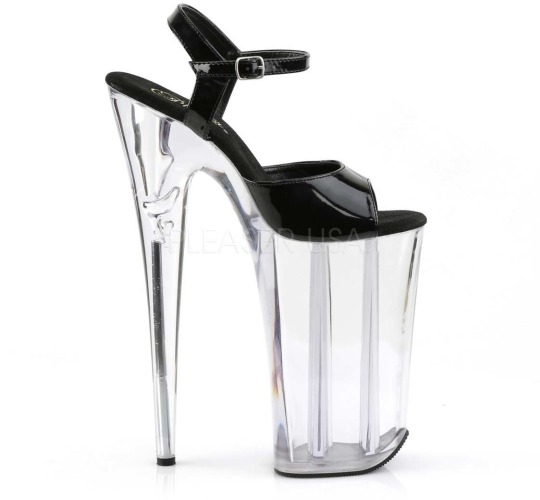
The look was completed with the Pleaser Beyond-009 black vinyl open-toe sandals with acrylic transparent platforms.

Backstage, Gaga stunned in a crystal choker and a Houghton Fall/Winter 2013 champagne silk satin boxy suit with oversized fit and peak lapels.
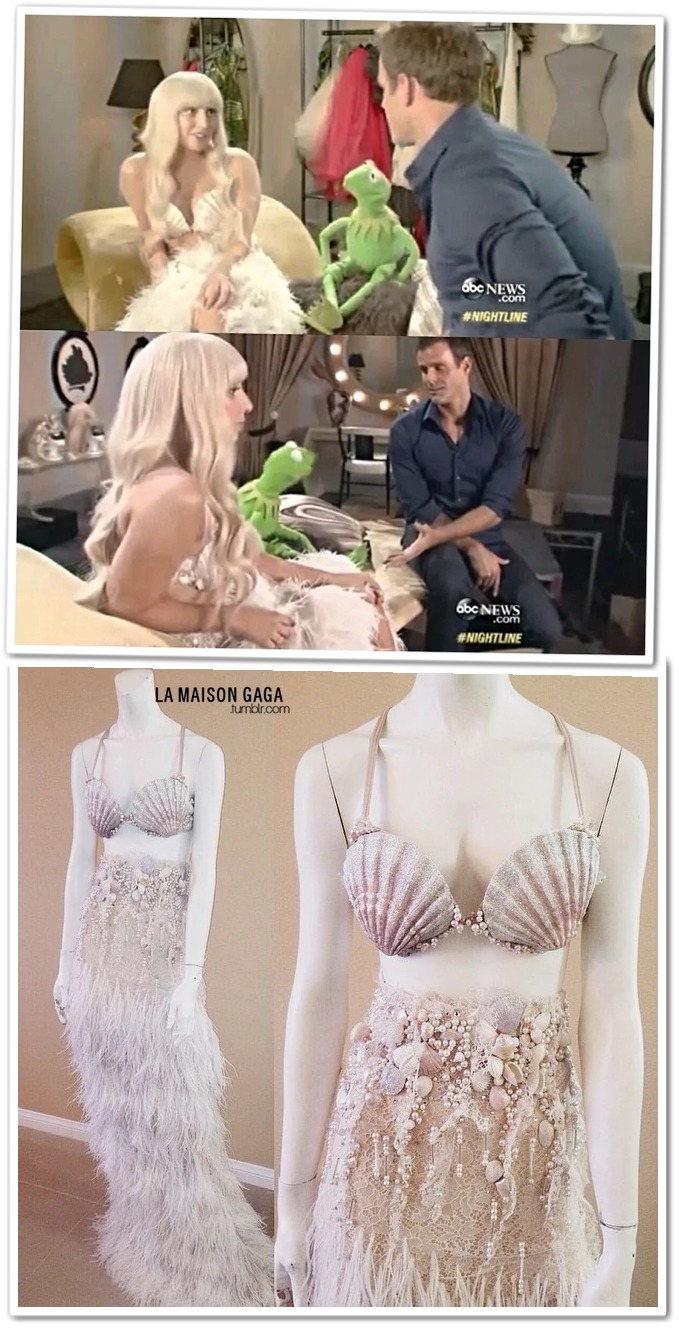
Last but not least, the interview look. Gaga wore a custom Bryan Hearns seashell ensemble. Both the shimmering bra bustier and the high-waisted skirt, are hand embellished with pearls, glass beads, and an assortment of seashells.
The skirt is made of layers of lace, sequin and feathers to mimic the coral reef.
#Maggie Barry#Le Silla#MYKITA#Bernhard Willhelm#Helen Yarmak#Dsquared2#Franka#Rare Vintage#Jean Paul Gaultier#Erickson Beamon#House of Lavande#Giuseppe Zanotti#a morir#John Galliano#Alon Livne#Houghton#Bryan Hearns#Adrienne Landau#Philip Treacy#YSL#Versace#Alaia#Pleaser
14 notes
·
View notes
Text
Superhero_Nephilim commented on The Adventures of Raily with: Ray/Lily + "Hey Mick, wanna be my best man?" Or Ray asking someone (bonus points for asking Mick) to be his best man at his wedding???
AO3
“He’ll say yes,” Lily told him over the phone.
“I’m hoping so,” Ray replied as he walked to the bar where he’d asked Mick to meet him. “He could say no.”
“It’s simple. Just say ‘hey Mick, wanna be my best man’?”
Ray opened the door to the bar. “Well, I’m going to ask him that now. Call you back later. I love you.”
“Love you too.”
He hung up and made his way over to where Mick was seated. His friend was drumming his fingers on the surface of the counter. Ray slipped onto a stool beside him with a grin. It had been a while since the two had last met up. “Hey, Mick.”
“Haircut,” the other man nodded in response as the bartender approached them.
“Can we get two beers?” Ray asked before looking back over at Mick. “Thanks for meeting me here, by the way.”
Two bottles, caps pulled off, were set down in front of them. The bartender walked off as Mick picked up one of them.
“Won’t turn down free booze,” Mick shrugged. “You said you had something to tell me?”
“Yeah,” Ray smiled a little. “So Lily and I are getting married.”
Mick nodded. “Congrats.”
“Thanks,” he replied as Mick took a drink from his beer. “We’ve been working hard to get everything ready. There’s setting a date and finding a venue and a bunch of other stuff. One of those things is finding a best man.”
“Okay.”
“i’ve thought a lot about this,” Ray continued. “Last time, I never got around to all of this. I’ve fallen out of touch with the guy I wanted to be my best man last time around. Now, with Lily, this is going to be one of the biggest days of my life. I’m already going to be standing up there with the woman I love, and I want the guy whose important in my life to be up there together.
Mick sighed. “Haircut, I’m not gonna help you pick your best man.”
“No,” Ray shook his head. “I’ve already got someone in mind.”
“Who’s that?”
“You,” Ray smiled. “Mick, wanna be my best man?”
Mick stared at him, eyes wide. He was completely still.
“Mick?”
The man continued to stare at him.
Ray raised an eyebrow. “Uhhh, Mick?”
Still nothing. It was starting to get unnerving.
“Mick, are you okay?”
Finally, Mick shook his head and snapped out of his daze. “You serious?”
“Of course,” Ray smiled. “You’ve been saving my ass and looked out for me more times than I can count. If there’s anyone I want up with me when I’m marrying the love of my life, it’s you. So what do you say?”
Mick went quiet for a moment before nodding. “Sure.”
“Really?” Ray asked, perking up.
“Yes, Haircut,” Mick nodded again. “I’ll be your best man.”
Ray raised his beer. “Thank, buddy, Cheers.”
Mick clinked his bottle against Ray’s. “I’ve done this gig once for Len. I can pull it off again for you and Stein Jr.”
Prompt-a-thon
7 notes
·
View notes
Text
on my birth chart & w. sidereal
LONG ASS TANGENT THAT NO ONE BUT ME COULD EVER POSSIBLY CARE ABT BELOW LOL. i just needed to put it into words somewhere 4 myself.
when i first discovered the sidereal zodiac something clicked, like, automatic. i don’t want this to get confused as me trying to push anyone’s hand, to accept a system that does not resonate- although i definitely think it’s worth some digging, i really do. but i understand we all see through a different lens. some pick up what others put down and vice-versa. i 100% believe that both can be valid simultaneously- to each their own! but i was just in the shower thinking about how much sense My personal placements shifting { a little to the east or a little to the west } just Makes. i’m still a virgo rising and an aries sun. my moon shifts to sagittarius which DID throw me for a loop at first lmao. i’ve always clung very tightly to my capricorn moon, although it’s in detriment, it just made sense to me. but with further inspection it came together. a cap moon always resonated because of how quickly i push things away and how i just have trouble making sense of my emotions in general. but there were things that did not resonate, too. i don’t feel that my lower, emotional, instinctive self has trouble feeling necessarily- not to say that cap moons don’t feel but they are considered more detached- i’m steeped in my feelings. but sag moons, and the pada my moon falls into in particular (vedic- which utilizes the sidereal zodiac)- has trouble taking their feelings and connecting them to the outer world. a break in connection. they’re described as more carefree, expansion seeking (i def did not ID w/ the ‘traditional’ trope of capricorn+saturn placements), c h a n g e seeking. i feel like people on the outside who don’t understand my inner workings (which is ofc most ppl) might see me as saturnian in my emotions but i don’t really agree, they’re very, even OVERLY present at all times but connecting them to the surface, connecting w/ those around me through them, can be a bit foreign to me. which my moon in the 4th pada explains fully. along w/ that is my virgo asc: critical, nervous, detail-oriented, a bit of a ‘fixer.’ this is the lens i am filtered through when it comes to the general public. so it makes sense that this earthy screen door breaks up my fire to those who don’t know me well or those i don’t Want to know me well (sun, mars & saturn in the 8th house). place a hand on the screen and it’s hot, you can feel it on the other side, but the image is broken into bits n pieces. my sidereal pisces mercury on the other hand CLICKED instantly. dreamerrrr, to a T. a bit of a space-cadet. wonderful with words on paper and in my head, i love my inner monologue, but everything comes out discombobulated and easily misconstrued on the surface. as a kid i lived in my fantasies and when i say lived i mean LIVED like, convinced myself they were real because i indulged so often type-lived in them. lolll. i also like to make the point that because your sign only ever moves one over, it makes sense that my or your tropical chart could feel relatively homey. everything is connected, right? so why wouldn’t neighboring signs have energies and traits etc. that bleed into one another a bit? it’s all up to your interpretation anyhow. astrology is universal, it’s a tool for understanding at it’s baseline. and if everyone has different lenses, this makes sense. that’s why i don’t like when people try to invalidate those who make the switch to sidereal like ‘oh you just want a different sign’ ‘so you’re just saying you suddenly don’t relate to your tropical chart at all after utilizing it for X amount of time? sounds fake but OK...’ YK? LOL. energy is energy. energy bleeds. and aside from just that, the configuration (and this is the biggest piece of the puzzle for me) essentially just re-configures itself. scrambles all of the pieces into different places. in my chart in particular i see this, which is part of why the transition was so easy to make sense of for me, i think. i can totally understand someone looking at their sidereal chart and being totally put-off if nearly all of their signs have shifted in different directions and EVERYTHING’S completely different, but like i said before, i still think it’s worth looking into and doing some uncovering because in most cases i believe it can make sense. but like i said before, everyone has their lenses and experiences and perceptions and i 100% believe BOTH zodiacs are valid! (7H mercury hiii) this is just my take. energy bleeds, it’s fluid, it moves. idk. just something to think about, if that makes any sense at all to anyone other than me lol. MOVING ALONG ! so yeah your mercury sign has a great impact on your perception+communication, right? it’s almost holding hands with my asc, in my mind. all of the signs+planets are holding hands in the grand scheme of things but my asc and mercury just Feel like BFFs (they are sister signs after all!!!). virgo+pisces working together to shape much of my perceptions+communications when it comes to the outer-world with my virgo asc sitting in the passenger seat and my pisces mercury sitting shotgun. ya, that’s perfect. then those close to me experience more of my fire+water combo, when my guard is down and i feel free to express my innards with a certain level of authenticity that my virgo would otherwise have it’s grip on. next is my aries mars which again, makes toooo much sense. tropical = taurus. slow to anger? uhhhhm? that was the first thing to pop into my mind. i’m very impulsive and angry and childish and reactionary and moves-too-fast-for-my-own-damn-good when i’m excited or angry- anything that brings drive into the equation. i want X outcome, thing, whatever & i want it N O W ! very me, lol. before i chalked this up to being my aries mercury (communication) & sun but again, it’s like i had 1,000 piece puzzle that i’ve been trying to finish forever and almost all of the pieces were in place but there were just a few with familiar edges that fit but not quite. and then sidereal came along and i was able to pop them all in place, exactly how they should be, and suddenly everything is clear as crystal. it still blows my mind to think about lmao. then my venus OH my VENUS ! in sidereal aquarius as opposed to tropical pisces. nownownow. another one that felt very RIGHT but i definitely did experience some trouble detaching from my pisces venus because aspects did makes sense. but. again. the fucking 1,000 piece puzzle. my pisces mercury + my aqua venus. those piscean, compassionate, dreamy, almost unconscious traits. i still felt them, they were very real, very there. it was just a matter of interpreting exactly where those traits tied back to. venus represents: “love, romance, sensuality, culture, beauty, affection and social appeal.” ! aquarius is: “progressive, original, independent, humanitarian.” i relate very very very much to aqua venuses. in love of all kinds very detached, extremely open-minded yet at times stubborn (seeing as aqua is fixed air), i feel suffocated without my independence like clingy-ness makes me feel like a wild dog (which could previously be chalked up to my aries stellium ofc) PARTICULARLY in romantic relationships. there is definitely some pride here as well (fixed). aquas a bit of an anomaly because it’s so extremely independent and One but at the same time humanitarian and forever-extending to contain More. ‘One’ can be interpreted that way, though, singularly or collectively. makes cents. in relationships i’ve always vowed to never ever ever say i love you first, make the first move, etc. because i’m too proud and too comfortable with being detached, leaving no room for painful rejection (my virgo asc also comes into play). but it was easy for me to mix that up w/ a pisces venus because of my pisces mercury- my communication style. my deeply empathetic Understanding and wish to understand, to unravel and envelope- all while being fiercely independent and determined to have a clear and defined Self within that curiosity and feel for all else. y’know? idk if this makes sense to anyone but me but it makes the MOST sense to me lol. 1,000 pieces. and when it comes to sidereal the arrangement is unnervingly Me. so yeah. that’s why i use sidereal LOL. { not getting into further placements bc do u see how fucking long this thing is already but believe me i’ve got plenty more where tht came from :p } TOODLES.
0 notes
Photo

New Post has been published on http://www.lifehacker.guru/spectacular-winners-insight-astronomy-photographer-year-2017/
Spectacular Winners Of The Insight Astronomy Photographer Of The Year 2017
“Stars and Nebulae”. Overall winner: The Rho Ophiuchi Clouds, by Artem Mironov (Russia) The Rho Ophiuchi Cloud Complex, or the Ophiuchus Molecular Cloud is a dark emission and reflection nebula about 14 light years across situated approximately 460 light years away from earth, in the constellation of Ophiuchus (the “Serpent-Bearer”). It is one of the closest star-forming regions to the Solar System. Hakos Farm, Windhoek, Namibia, 6 August 2016. Sky-Watcher 200 mm f/4 reflector telescope, Sky-Watcher HEQ5 Pro mount, Canon 5D Mark II camera, ISO 1600, 15-hour total exposure. (Photo by Artem Mironov/Insight Astronomy Photographer of the Year 2017)
“Stars and Nebulae”. Runner up: One Stellar Day by Andras Papp (Hungary) A 24 hour day actually only takes 23 hours, 56 minutes and 4 seconds for our planet spinning on its axis to complete one rotation – known as the “sidereal day” or “stellar day”. This image captures the motion of the stars over the course of one “stellar day” illustrated by beautiful concentric star trails. Ágasvár, Veszprémvarsány, Hungary, 2 November 2016 Canon EOS 700D camera, 18–135 mm at 135 mm f/7.1, Sky-Watcher HEQ5 mount with home-made camera holder, ISO 800, 287 x 300-second exposures. (Photo by Andras Papp/Insight Astronomy Photographer of the Year 2017)
“Stars and Nebulae”. Highly commended: NGC 281 Pacman by Andriy Borovkov (Ukraine) The NGC 281 nebula is known as the “Pacman Nebula” due to its resemblance to the video game character. In the ordinary colours of the visible light spectrum it can look rather dreary, so this image used the Hubble Palette (HST), showcasing the nebula with a vibrant blue surrounded by rusty oranges. Elmshorn, Germany, August/September 2016. UNC 30512 305 mm f/4 reflector telescope, Sky-Watcher EQ8 mount, Moravian Instruments G2-8300 Mono CCD camera, 25-hour total exposure. (Photo by Andriy Borovkov/Insight Astronomy Photographer of the Year 2017)
“Aurorae”. Winner: Ghost World by Mikkel Beiter (Denmark) During October 2016 the photographer stood and observed the waves from the sea slowly rolling up on the long beach making the sand wet, resulting in great conditions for catching some reflections. Suddenly, clouds emerged from the nearby mountains and floated across the sea allowing him to capture this other-worldly scene of a powerful, teal aurora sweeping across the night sky. Stokksnes, Iceland. Stokksnes, Iceland, 5 October 2016 Canon EOS 5D Mark III camera, 24 mm f/2.0 lens, ISO 1600, 6-second exposure. (Photo by Mikkel Beiter/Insight Astronomy Photographer of the Year 2017)
“Aurorae”. Runner up: In Autumn Dance by Kamil Nureev (Russia) A glowing green auroral ray arcs through the night sky over the Siberian forest-tundra. Eight vertical scenes shot – over the course of shooting, every second was precious as the polar light was very dynamic and the photographer had to move as quickly as possible to authentically capture the scene. The polar shine silhouette reminds the photographer of the mathematical “golden ratio”. Noviy Urengoy, Russia, 28 September 2016 Canon 5D Mark III camera, 24 mm f/2.0 lens, ISO 2000, 4-second exposure. (Photo by Kamil Nureev/Insight Astronomy Photographer of the Year 2017)
“Aurorae”. Highly commended: Aurora Shot from Plane by Ye Ziyi (China) The vivid green aurora swirls over the deep, blue sky and the orange glow of twilight as seen from the window of a plane travelling from Amsterdam to Beijing. The photographer had been expecting an auroral outburst to occur during the flight, so paid for the seat that was best for observing. As well as the strong auroral activity, the photographer was also blessed with a white night making twilight visible on the horizon. Novosbirsk, Russia, 24 August 2016 Canon EOS 6D camera, 20 mm f/1.8 lens, ISO 2000, 3-second exposure. (Photo by Ye Ziyi/Insight Astronomy Photographer of the Year 2017)
“Galaxies”. Winner: M63 – Star Streams and the Sunflower Galaxy by Oleg Bryzgalov (Ukraine) A bright, spiral galaxy, Messier 63 looks like a star necklace in which the stars have crashed outwards from the galaxy’s centre, producing this fantastic long train. The ghostly star arcs of the Sunflower galaxy had long been an elusive target for the photographer, finally shot in one of the darkest places in Europe. Rozhen Observatory, Smolyan Province, Bulgaria, 6 April 2016 10-inch f/3.8 homemade reflector telescope at f/4.4, Whiteswan 180 mount, QSI 583wsg camera, 22-hour total exposure. (Photo by Oleg Bryzgalov/Insight Astronomy Photographer of the Year 2017)
“Galaxies”. Runner up: NGC 7331 – The Deer Lick Group by Bernard Miller (USA) NGC 7331 is an unbarred spiral galaxy found some 40 million light years away from Earth, in the constellation Pegasus. Of the group of galaxies known as the Deer Lick Group, NGC 7331 is the largest, and can be seen dominating the image whilst the smaller galaxies NGC 7335, NGC 7336, NGC 7337, NGC 7338 and NGC 7340 drift above it. Animas, New Mexico, USA, 30 October 2016 PlaneWave CDK-17 17-inch reflector telescope at f/6.8, Paramount ME mount, Apogee CG16M camera, 18-hour total exposure. (Photo by Bernard Miller/Insight Astronomy Photographer of the Year 2017)
“Galaxies”. Highly Commended: NGC 4565 – Needle Galaxy by Andriy Borovkov (Ukraine) NGC 4565 in the constellation of Coma Berenices, approximately 40 million light years away, is known as the Needle Galaxy and is more luminous than our neighbouring galaxy, Andromeda. As we look at this galaxy from the side on Earth, the spiral arms are in a ray. Elmshorn, Pinneberg, Schleswig-Holstein, Germany, 14 March 2016 UNC 30512 300 mm f/4 reflector telescope, Sky-Watcher EQ8 mount, Moravian Instruments G2-8300 mono camera, 9.-hour total exposure. (Photo by Andriy Borovkov/Insight Astronomy Photographer of the Year 2017)
“Our moon”. Winner: Blue Tycho by László Francsics (Hungary) This hyper-saturated picture shows our lunar surface in a new light. The Tycho Crater, has a bluish shade that is characteristic of the youngest craters on the moon. Budapest, Hungary, 12 December 2016 250 mm f/4 reflector telescope at f/10, Sky-Watcher EQ6 mount, ZWO ASI290MM and Sony SLT A99V cameras, composite of 5000 monochrome frames and 50 colour frames. (Photo by László Francsics/Insight Astronomy Photographer of the Year 2017)
“Our moon”. Runner up: Evening in the Ptolemaeus Chain and Rupes Recta Region by Jordi Delpeix Borrell (Spain) A close up of the craggy face of the moon, shows the south central lunar face is dominated by the magnificent chain of walled plains: Ptolemaeus, Alphonsus and Arzachel. L’ Ametlla del Vallès, Barcelona, Spain, 25 August 2016 Celestron C14 355.6 mm f/11 Scmidt-Cassegrain telescope at f/19, Sky-Watcher NEQ6 Pro mount, ZWO ASI 174MM camera, 500 of 6600 frames stacked. (Photo by Jordi Delpeix Borrell/Insight Astronomy Photographer of the Year 2017)
“Our moon”. Highly commended: Mauna Kea Moonset by Sean Goebel (USA) A giant moon looms behind the telescopes atop the snow-capped dormant volcano, Mauna Kea. Despite being in Hawaii, Mauna Kea is tall enough (4,200m) to accumulate snow during the winter. The telescopes are, from left to right, the UK Infrared Telescope, the University of Hawaii 2.2m telescope, Gemini North, and Canada France Hawaii Telescope. Hilo, Hawaii, USA, 13 January 2017 Canon EOS 7D Mark II, 1000 mm f/11 lens, ISO 320, 1/500-second exposure. (Photo by Sean Goebel/Insight Astronomy Photographer of the Year 2017)
“Our sun”. Winner: Mercury Rising by Alexandra Hart (UK) On 9 May 2016, the Transit of Mercury occurred, with the smallest planet in the solar system passing directly between the Earth and the sun over the course 7.5 hours – the longest transit of the century. Mercury can be seen towards the centre of our star in the image as a tiny black dot. Preston, Lancashire, UK, 9 May 2016 TEC140 140 mm f/7 refractor telescope at f/9.8, Solarscope DSF100 H-alpha filter, Sky-Watcher EQ6 Pro mount, PGR Grasshopper 3 camera, stacked from multiple exposures. (Photo by Alexandra Hart/Insight Astronomy Photographer of the Year 2017)
“Our sun”. Runner up: Solar Limb Prominence and Sunspot by Eric Toops (USA) A striking image of a searing solar limb prominence and sunspot on the surface of our star, taken during the spring of 2016. Using Lunt H-alpha filters in a custom-made telescope the photographer was able to bring out the details of the solar activity using high magnification. Several photos were stacked to stabilize the image and the “seeing conditions” (the blurriness of the Earth’s atmosphere). Hoschton, Georgia, USA, 19 April 2016 Home-made telescope, Point Grey GS3-U3-60S6M camera. (Photo by Eric Toops/Insight Astronomy Photographer of the Year 2017)
“Our sun”. Highly commended: Ghostly Sun by Michael Wilkinson (UK) The sun photographed in Calcium-K light, depicting the star’s inner chromosphere. In the colour-rendering scheme used, the surface is shown as negative, with the sunspots as bright spots, but the area outside the limb is shown with increased contrast, highlighting a surge on the western limb, and several small prominences. Groningen, Netherlands, 4 April 2017 APM 80 mm f/6 refractor telescope, Vixen Great Polaris mount, ZWO ASI178MM camera, stack of 400 frames. (Photo by Michael Wilkinson/Insight Astronomy Photographer of the Year 2017)
“Planets, Comets and Asteroids”. Winner: Venus Phase Evolution by Roger Hutchinson (UK) The changing face the planet Venus as it grew from 86.6% illuminated and 11.9 inches in diameter on the 25th September 2016, to 1% illuminated and 59.3 inches in diameter six months later. The images were taken with the same setup, so the changing size of Venus, as it approached the point between us and the sun, is apparent. London, UK, 25 March 2017 Celestron C11 EdgeHD 355.6 mm f/10 reflector telescope, Celestron CGE Pro mount, ZWO ASI174MM camera, composite of panels stacked from multiple exposures. (Photo by Roger Hutchinson/Insight Astronomy Photographer of the Year 2017)
“Planets, Comets and Asteroids”. Runner up: Retrograde Mars and Saturn by Tunç Tezel (Turkey) The paths of the planets Mars and Saturn shown swooping through the night sky, over a period of 11 months in 2016. Last year was a special year for monitoring the two planets because they spent the year close to each other, north of Antares in Scorpius. The planets were photographed on 46 different dates over 11 months, roughly once per week. Pulau Plun, Halmahera, Indonesia, 9 March 2016 Canon EOS 6D camera, 50 mm f/3.5 lens, ISO 3200, composite of multiple exposures. (Photo by Tunç Tezel/Insight Astronomy Photographer of the Year 2017)
“Planets, Comets and Asteroids”. Highly commended: Near Earth Object 164121 (2003 YT1) by Derek Robson (UK) On 31 October 2016, Near Earth Asteroid 164121 (2003 YT1) made a close encounter with Earth at 3 million miles. This Apollo asteroid with an orbital period of 427 days was discovered by the Catalina Sky Survey on 18 December 2003. The photographer’s first attempt at imaging the asteroid was done with a camera on a fixed tripod, controlled by Astrophotography Tool software. Loughborough, Leicestershire, UK, 2 November 2016 Canon 1100D, 300 mm f/5.6 lens, ISO 1600, 56 x 25-second exposures. (Photo by Derek Robson/Insight Astronomy Photographer of the Year 2017)
“Skyscapes”. Winner: Passage to the Milky Way by Haitong Yu (China) The serene sight of the dusky, Milky Way viewed through the minimalist outdoor passageway of LAMOST (the Large Sky Area Multi-Object Fibre Spectroscopic Telescope) at the National Astronomical Observatory of China. Shot with an 85 mm lens, the image is a composite of a three-panel panorama, each one with a single exposure. Xinglong, Hebei Province, China, 9 April 2016 Sony ILCE-7s camera, 85 mm f/1.4 lens, ISO 10000, panorama of three 8-second exposures . (Photo by Haitong Yu/Insight Astronomy Photographer of the Year 2017)
“Skyscapes”. Runner up: Star Track in Kawakarpo by Zhong Wu (China) The stars beam down on to the Meili Snow Mountains, also known as the Prince Snow Mountains – the highest peaks in the Yunnan Province, China. It is world-renowned for its beauty and is one of the most sacred mountains in Tibetan Buddhism. The moonlight striking the top of the mountains appears to give them an ethereal quality. DeQin, Yunnan Province, China, 16 January 2017 Nikon D810 camera, 35 mm f/5.6 lens, ISO 200, 900-second exposure. (Photo by Zhong Wu/Insight Astronomy Photographer of the Year 2017)
“Skyscapes”. Highly commended: Nacreous Clouds by Bartlomiej Jurecki (Poland) A spectrum of colour rolls across the sky over Lofoten, Norway in the form of nacreous clouds, also known as mother-of-pearl clouds due to their almost shimmering appearance. Formed over the Polar Regions in the stratosphere, when the Sun is just below the horizon at sunset it will illuminate the clouds from below. Lofoten, Norway, 31 December 2016 Nikon D800 camera, 300 mm f/7.1 lens, ISO 10, 1/800-second exposure. (Photo by Bartlomiej Jurecki/Insight Astronomy Photographer of the Year 2017)
“Young Astronomy Photographer of the Year”. Highly commended: Milky Way above Alpe di Siusi/Dolomites by Fabian Dalpiaz (Italy – aged 15) The Milky Way stretches across the night sky above the Dolomites in South Tyrol at 5.00 a.m. on a really cold winter morning. Reaching the spot at 4.00 a.m. the photographer waited for the Milky Way to reach its highest position before it got brighter to capture this beautiful scene. Seiser Alm, South Tyrol, Italy, 25 February 2017 Canon EOS 5D Mark III camera, 50 mm f/1.8 lens, ISO 6400, 10-second exposure. (Photo by Fabian Dalpiaz/Insight Astronomy Photographer of the Year 2017)
“Young Astronomy Photographer of the Year”. Highly commended: Rosa Mountain by Andrea Imazio (Italy – aged 8) Taken during a crystal clear winter night as a single long exposure, this image shows the stars glistening above the Rosa Massif Mountain in the Alps. Gressoney, Aosta Valley, Italy, 3 January 2017 Nikon D5500 camera, 18 mm f/3.5 lens, ISO 1600, 20-second exposure. (Photo by Andrea Imazio/Insight Astronomy Photographer of the Year 2017)
“Sir Patrick Moore Prize for Best Newcomer”. Winner: The Cone Nebula (NGC 2264) by Jason Green (Gibraltar) A vivid deep-red image of the Cone Nebula, lying about 2,700 light years away in the constellation of Monoceros. The image consists of 20 x 10-minute exposures per filter and is an integration of LRGB (luminance, red, green and blue) and H-Alpha (hydrogen-alpha) filters. Frenegal de la Sierra, Badajoz, Spain, 10 January 2017 William Optics 132 mm f/5.6 apochromatic refractor telescope, Celestron CGE Pro mount, QSI 660WSG8 Mono CCD camera, 16 2/3-hour total exposure. (Photo by Jason Green/Insight Astronomy Photographer of the Year 2017)
“Robotic Scope”. Winner: Encounter of Comet and Planetary Nebula by Gerald Rhemann (Austria) A vibrant image showing the glowing green, comet C/2013 X1 PanSTARRS whizzing past the luminous pink and blue Helix Planetary Nebula, on 5 June 2016. This photograph was taken at an observatory on Tivoli Farm in Namibia, where the photographer installed a mount and telescope with a friend of his. Tivoli Farm, Khomas, Namibia, 5 June 2016 ASA Astrograph 12-inch N 300 mm f/3.6 reflector telescope, ASA DDM 85 mount, FLI Microline ML 16200 camera, 94-minute total exposure. (Photo by Gerald Rhemann/Insight Astronomy Photographer of the Year 2017)
“People and Space”. Winner: Wanderer in Patagonia by Yuri Zvezdny (Russia) A lone stargazer stares up at the stars of our galaxy, the Milky Way, as they stretch across the night sky over the glacier “White Stones” (Piedras Blancas) in the Los Glaciares National Park, Argentina. El Chaltén, Santa Cruz Province, Argentina, 27 September 2016 iOptron Sky-Tracker mount, Sony A7S camera, 18 mm f/2.8 lens, ISO 5000, 30-second exposure Wanderer in Patagonia. (Photo by Yuri Zvezdny/Insight Astronomy Photographer of the Year 2017)
“People and Space”. Runner up: The Cable Route of Half Dome at Night by Kurt Lawson (USA) The photographer along with fellow astrophotographer Sean Goebel embarked on a mission to shoot a night hike up the Cable Route of Yosemite’s incredible Half Dome. Nearly clear skies allowed for the capture of the movement of the stars above this incredible landscape and shooting it at night allowed them to capture the path up Yosemite’s famous granite icon. Yosemite National Park, California, USA, 29 August 2016 Sony α7R camera, 100 mm f/2.8 lens, ISO 500, 64-minute exposure. (Photo by Kurt Lawson/Insight Astronomy Photographer of the Year 2017)
“People and Space”. Highly commended: Interstellar Travel by Fu Dingyan (China) In an attempt to recreate feeling of travelling in space, the photographer escaped the lights of the city and ventured to Réunion Island, located off the coast of Madagascar. Dressed in a spacesuit, standing under the southern Milky Way and the Large and Small Magellanic Clouds, the photographer resembles an interstellar traveller Réunion Island, France, 3 September 2016 Nikon D4S camera, 14-24 mm lens at 14 mm f/2.8, ISO 500, 30-second exposure. (Photo by Fu Dingyan/Insight Astronomy Photographer of the Year 2017)
(C)
0 notes